With high-end hardware and software features trickling down to affordable price brackets, mid-range TVs keep getting better. Take the Hisense U7H and the Samsung Q60B: These two budget-friendly TVs perform better than the budget-friendly TVs of yesteryear and arrive with a host of fancy features for gaming and beyond.
They’re so similar, in fact, that it can be tough to figure out which is right for you. That’s where we come in. We spend all year testing TVs like the U7H and the Q60B—from picture quality to smart platform speed. Here’s what you need to know.
Buy the Hisense U7H at Best Buy
Buy the Samsung Q60B at Amazon
Price
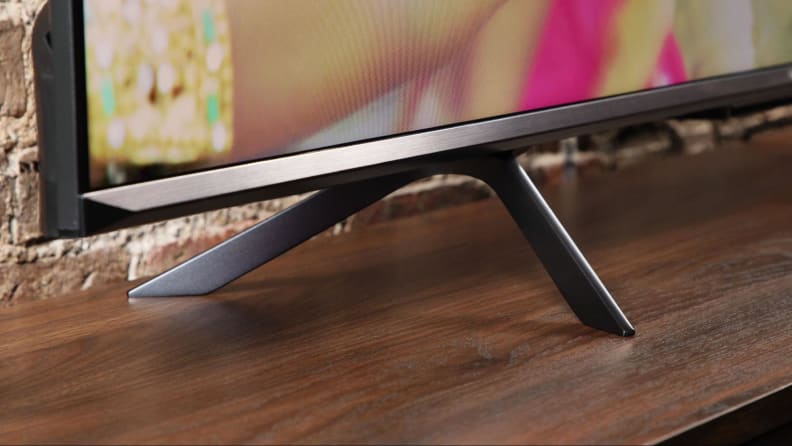
Credit:
Reviewed / Tim Renzi
The Hisense U7H (seen here) is available in four size options, while the Samsung Q60B is available in eight.
Some TV sizes have been marked down since their release. For the sake of context, I’m reporting both the original list and lowest current sale price I could find for each at the time of publishing.
There’s no guarantee that these sale prices will remain the same by the time you read this, but going forward, I don’t expect the costs to climb much further.
Hisense U7H:
The Hisense U7H is available in four screen sizes ranging from 55 to 85 inches. They were discounted very soon after their initial release, and they remain marked down today.
Next, let’s see how Samsung’s mid-range QLED stacks up.
Samsung Q60B:
- 43-inch (Samsung QN43Q60BAFXZA), $549.99 (on sale for $547.99 at Amazon)
- 50-inch (Samsung QN50Q60BAFXZA), $649.99 (on sale for $647.99 at Amazon)
- 55-inch (Samsung QN55Q60BAFXZA), $749.99 (on sale for $697.99 at Amazon)
- 60-inch (Samsung QN60Q60BAFXZA), $899.99 (on sale for $797.99 at Amazon)
- 65-inch (Samsung QN65Q60BAFXZA), $999.99 (on sale for $947.99 at Amazon)
- 70-inch (Samsung QN70Q60BAFXZA), $1,199.99 (on sale for $997.99 at Amazon)
- 75-inch (Samsung QN75Q60BAFXZA), $1,399.99 (on sale for $1,129 at Amazon)
- 85-inch (Samsung QN85Q60BAFXZA), $1,999.99 (on sale for $1,599.99 at Amazon)
The Samsung Q60B is available in eight total sizes ranging from 43 inches to 85 inches—twice as many as the U7H. Every size in the U7H series is represented in the Q60B series, but Samsung also offers the Q60B in 43-, 50-, 60-, and 70-inch models.
The added flexibility of the Q60B series is nice to have in your back pocket, particularly if you’re looking to maximize space and you’re stuck between the most popular size options of 55, 65, and 75 inches. That said, all sizes of the U7H are currently priced lower than their Q60B counterparts.
Our pick: Draw
Design
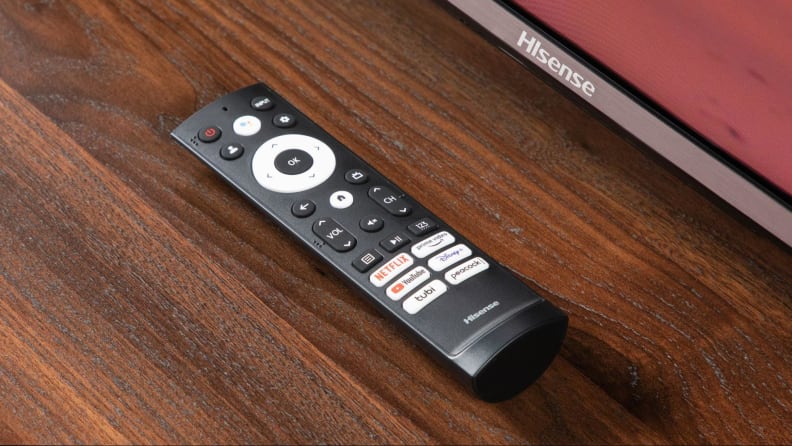
Credit:
Reviewed / Tim Renzi
The Hisense remote control gets the job done, but we much prefer Samsung’s Solar Cell remote control.
The U7H’s best design flourish is its multiple stand slots, which allow you to configure the TV’s boomerang-shaped feet in two different configurations. One of these configurations keeps the U7H’s feet closer to the center of the panel, which can be a lifesaver for folks who are trying to prop up their TV on a narrow media console.
Once set up, the U7H sports a generic, fuss-free look. The hefty panel (which widens out at the bottom) sits about 2.5 inches off its surface, allowing a fair amount of clearance for most soundbars. The Hisense remote control (which features a built-in microphone for voice commands) gets the job done, but its chunky buttons and beefy dimensions are the opposite of sleek.
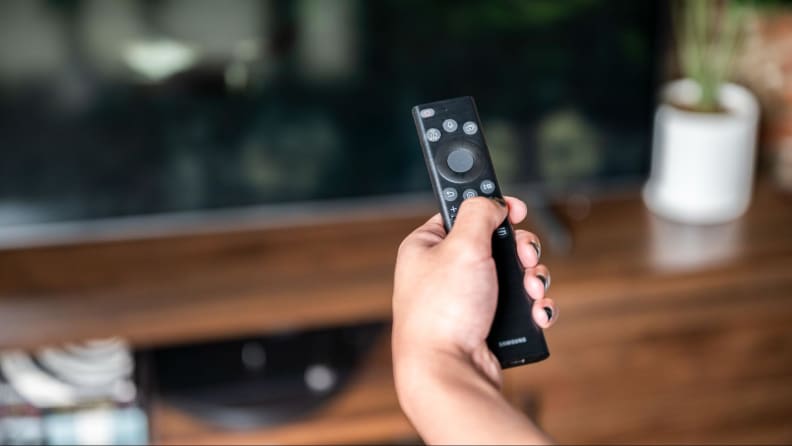
Credit:
Reviewed / Betsey Goldwasser
If you’re in need of a charge and don’t have time to let Samsung’s Solar Cell remote charge itself, you can always charge it manually via a USB-C port on the bottom of the remote.
The Q60B ships with the newest version of Samsung’s Solar Cell remote control, which uses indoor/outdoor light and RF waves to charge its internal battery. There’s also a USB-C charging port for emergency charging.
The Q60B is also a swankier-looking TV than the U7H. The panel is uniformly narrow with slim, L-shaped feet that call attention to themselves less than the U7H’s feet. Setting up the Q60B is a cinch, too. The TV’s feet slot right into the panel and remain firmly in place—no screws required.
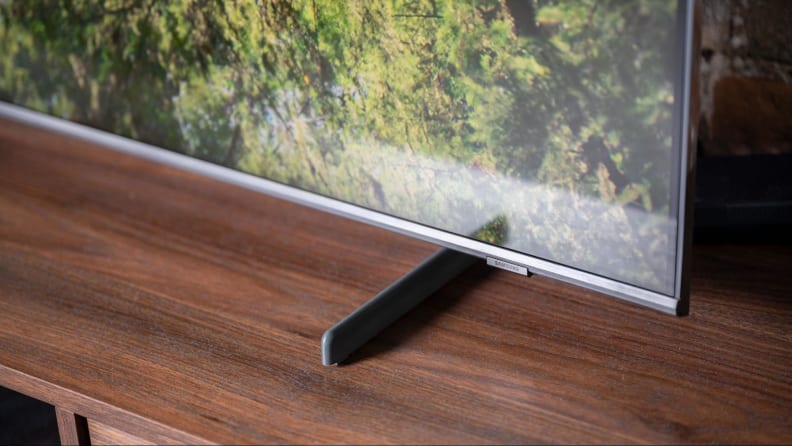
Credit:
Reviewed / Betsey Goldwasser
The Q60B’s feet conveniently slot into the panel without the use of a screwdriver.
Unlike the U7H, there’s only one stand configuration available for the Q60B. In addition, once the feet are in place, the Q60B only allows about 1.5 inches of clearance for a soundbar.
Nevertheless, the slim, self-charging Solar Cell remote and the Q60B’s uniformly narrow design makes it the nicer-looking option of the two.
Our pick: Samsung Q60B
Features and smart platform
The U7H and the Q60B offer many of the same hardware and software features. Before we dive into what sets them apart, let’s take a look at the features shared by both TVs.
- Resolution: 4K (3,840 x 2,160)
- Display type: LED with quantum dots
- HDR support: HDR10+. HDR10, HLG
- Dolby Atmos: Yes
- eARC support: Yes
- Native refresh rate: 60Hz
- Color: DCI-P3 color space/10-bit chroma resolution
- Auto Low Latency Mode (ALLM): Yes
-
Other features: Google Assistant, Amazon Alexa, Apple AirPlay 2
Credit:
Reviewed / Betsey GoldwasserThe Q60B’s feet conveniently slot into the panel without the use of a screwdriver.
Cinephiles will be pleased to learn that the Hisense U7H supports Dolby Vision, a popular, proprietary version of HDR whose compatible titles can be found on Blu-ray and streaming platforms like Netflix. Like all Samsung TVs, the Q60B rejects Dolby Vision in favor of HDR10+, a royalty-free version of the format that works in a similar manner. There are plenty of HDR10+ titles out there (Amazon Prime Video offers a host of HDR10+ titles, for instance), but Dolby Vision is, nevertheless, the more popular format. With the U7H, you’re getting both Dolby Vision and HDR10+.
Both TVs offer a taste of next-gen gaming features with Auto Low Latency Mode, a feature that automatically detects gaming consoles and adjusts the TV’s performance accordingly, lowering input lag. However, the U7H takes it a step further by offering Variable Refresh Rate, which ensures extra-smooth gaming, free of visual artifacts. Neither TV supports 4K gaming at 120Hz.
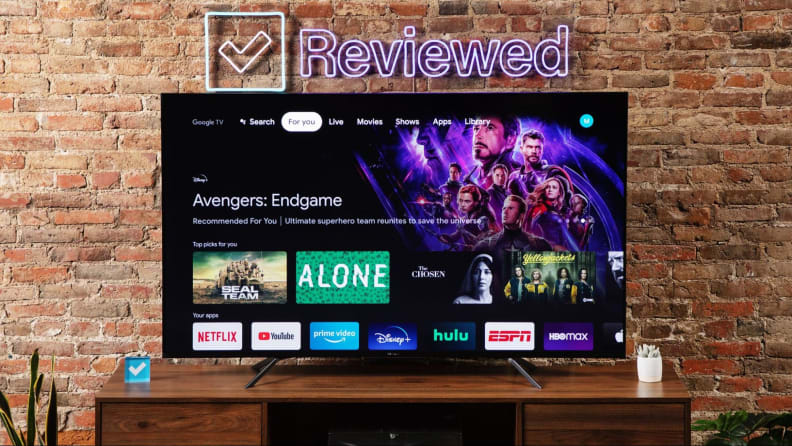
Credit:
Reviewed / Tim Renzi
The U7H (seen here) runs on Google TV.
The biggest experiential difference between the two TVs lies in their smart platforms. The U7H comes with Google TV built right in. A successor to Android TV, Google’s software is easy to pick up and use on the fly, and navigation is quite zippy.
The Q60B, on the other hand, arrives with the newest version of Samsung’s Tizen-based smart platform. Compared to Google TV, Tizen is sluggish and more confusing to navigate. Jumping from one input to another, for instance, takes more clicks than it ought it to, and basic button commands will often lag behind what’s happening on screen.
So, to recap: The U7H offers Dolby Vision support, Variable Refresh Rate, and a faster, easier-to-use smart platform. When it comes to features, the U7H has the edge.
Our pick: Hisense U7H
Performance
Both of these LED TVs feature a layer of color- and brightness-boosting quantum dots—a feature that only made its way to mid-range TVs relatively recently. However, while our lab tests indicate that the Q60B covers about 84% of the HDR color gamut (DCI-P3), the U7H is a bit more colorful, covering about 93% of DCI-P3.
And then there’s the matter of viewing angle. While the picture on both TVs lose contrast and exhibit light bloom from off-axis viewing positions, the Q60B also demonstrates severe color shifting. At just 30° away from a head-on angle, the Q60B shifts yellows into pale green, for instance.
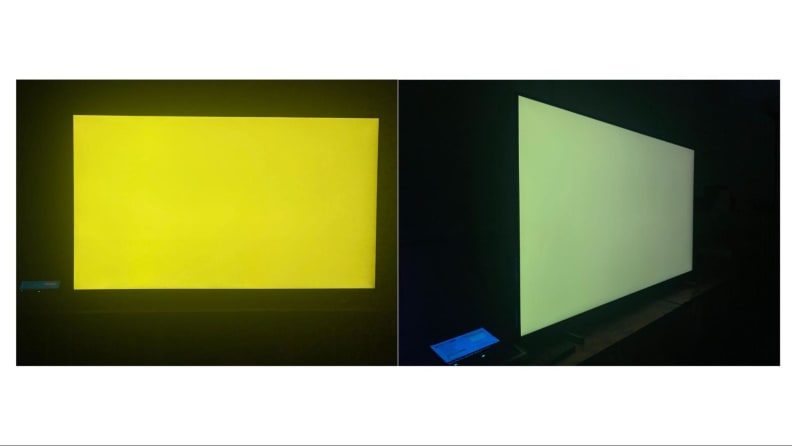
Credit:
Reviewed / Michael Desjardin
The Q60B (seen here) suffers from extreme color shifting when viewed off-axis.
As mentioned, light bloom is present on both TVs, but the U7H is better in this regard, thanks to its full-array local dimming. Because of its Dual LED backlight technology, the Q60B isn’t as adept at focusing its brightness on smaller highlights. This makes HDR content on the Q60B look relatively dull and flat compared to the U7H.
And, when it comes to brightness, the U7H runs circles around the Q60B. Not only is its average, full-field brightness higher than the Q60B, its specular highlights get twice as bright, too. On the U7H, we measured a peak HDR brightness of around 1,000 nits. The Q60B was unable to crack 600 nits. In practice, this means that HDR content will pop much better on the U7H, whether you’re playing an HDR game or watching an HDR title on Netflix.
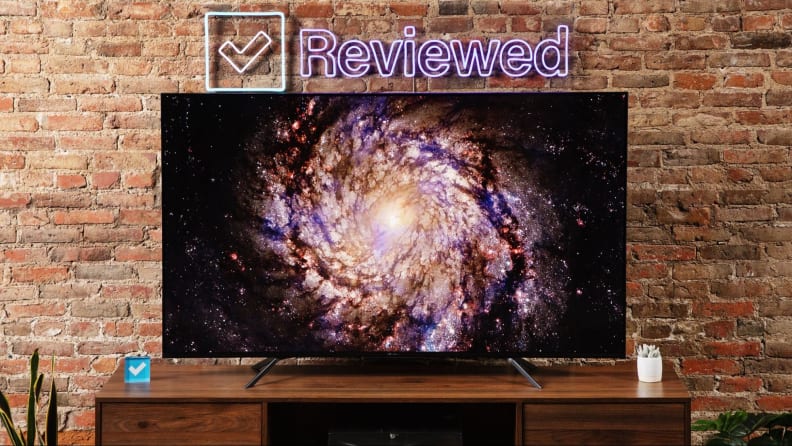
Credit:
Reviewed / Tim Renzi
The U7H (seen here) delivers better brightness and contrast control than the Samsung Q60B.
If there’s one major advantage that the Q60B has over the U7H, it’s undoubtedly Samsung’s picture processing, which upscales sub-4K content much more cleanly than Hisense’s picture processing software. Cable TV, YouTube videos, and over-the-air broadcasts don’t look that bad on the U7H, but there are far more artifacts than what you can expect to see from the Q60B. In addition, the U7H displays some unfortunate red-tinted color fringing on characters and objects in motion—something we’ve seen from many Hisense TVs in the last few years.
Even so, every other aspect of the U7H’s performance—color, brightness, and overall contrast—presents a clear advantage over the Q60B.
Our pick: Hisense U7H
And the winner is…
The Hisense U7H is a better pick for most people over the Samsung Q60B. While the Q60B offers a more pleasing design and twice as many size options, the U7H delivers a brighter picture, better contrast control, and a superior smart platform. It also supports Dolby Vision and Variable Refresh Rate, making it a wise choice for film fans and game enthusiasts on a budget.
If you’re in the market for a 43-, 50-, 60-, or 70-inch TV, the choice isn’t as clear cut, as those size options aren’t available in the U7H series. If you’re satisfied with a 55-, 65-, 75-, or 85-inch TV, however, the U7H is an all-around better pick.
Buy the Hisense U7H at Best Buy
Buy the Samsung Q60B at Amazon
The product experts at Reviewed have all your shopping needs covered. Follow Reviewed on Facebook, Twitter, Instagram, TikTok, or Flipboard for the latest deals, product reviews, and more.
Prices were accurate at the time this article was published but may change over time.











